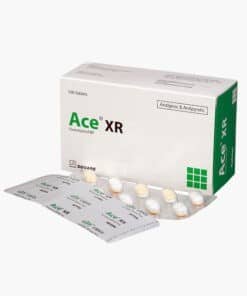Clob | 10 mg | Tablet | 10 pcs
৳ 38.50
Brand Name: Clob Tablet
Generic: Clobazam
10 mg
Opsonin Pharma Ltd.
Unit Price: ৳ 3.85 (10 x 10: ৳ 385.00)
Strip Price: ৳ 38.50
Indications
Therapeutic Class
Pharmacology
Dosage
Pharmaceutical presentation dosage, and duration of treatment must be adjusted to the individual clinical response, the indication, and the severity of the condition. Due regard must be paid to the possibility of interference with alertness and reaction time. The fundamental principle is to keep the dose as low as possible.
In patients with impairment of hepatic or renal function, Clobazam must be administered in reduced doses; in long term treatment hepatic and renal functions should be checked regularly, as a precaution. When treatment with Clobazam is to be discontinued after prolonged administration, the dosage should normally be tapered off over a period of time.
Treatment of anxiety states: The initial dose is usually 20 mg Clobazam daily. If necessary, the daily dose may be increased to 30 mg. For elderly patients, a total daily dose of 10-15 mg is often enough. For Children between 3 and 15 years of age, a daily dose of 5-10 mg is frequently sufficient.
Discontinuation of treatment of anxiety states: After improvement of the symptoms, the dose may be reduced. After prolonged treatment, Clobazam should not be withdrawn suddenly. The dose should be reduced gradually under medical supervision, otherwise symptoms such as restlessness, anxiety, and insomnia may occur.
Treatment of epilepsy: As with other benzodiazepines, the possibility of a decrease in anticonvulsant efficacy in the course of treatment must be borne in mind.
Dosage in adults and adolescents over 75 years of age: Small doses (5-15 mg/day as the initial dose), gradually increasing to maximum daily dose of about 80 mg. Furthermore, constant doses (e.g. 20 mg/day) and intermittent therapy (discontinuing Clobazam and subsequently prescribing it again) have proved effective.
Combined treatment with one or more other antiepileptics in children from 3 to 15 years of age: Treatment should normally be started with 5 mg, and a maintenance dose of 0.3-1.0 mg/ kg body weight daily is usually enough.
Discontinuation of treatment or combined treatment of epilepsy: At the end of treatment- also in cases where there has been a poor response to therapy- the dose should be gradually reduced, because otherwise an increased proneness to seizures cannot be excluded.
Administration
Interaction
Contraindications
Side Effects
Symptoms of tiredness may sometimes appear, especially at the beginning of treatment and when higher doses are used. Also in rare instances and usually only temporarily-the patient may experience dryness of the mouth, constipation, loss of appetite, nausea, dizziness, or a fine tremor of the fingers. Another possibility is the emergence of paradoxical reactions (e.g. restlessness, irritability, acute agitational states, anxiety, suicidal tendencies, frequent muscle spasms, difficulty in falling asleep and to sleep through). In the event of such reactions, treatment with Clobazam should be discontinued. Slowing of reaction time, ataxia, drowsiness, confusion and headaches may occasionally occur. Cutaneous reactions, such as eruptions or urticaria, have been observed in isolated cases.
Impairment of respiratory function may become manifest in certain diseases of the respiratory passages (airways obstruction, e.g. in bronchial asthma) and in patients with brain damage. After prolonged use of benzodiazepine, impairment of conciousness, sometimes combined with resiratory disorders, has been reported in very rare cases, particularly in elderly patients: it sometimes persists for some length of time. Especially in patients receiving high doses of long-term treatment, there may be reversible abnormalities such as slowing or indistinctness of speech (disorders of articulation), lack of confidence in walking and other motor functions, visual disorders (double vision, nystagmus), weight gain or loss of libido. When used as an adjuvant in the treatment of epilepsy, this preparation may, in rare case, cause restlessness and muscle weakness.
Pregnancy & Lactation
Precautions & Warnings
Special caution is necessary if Clobazam is to be administered to patients with serious pathological muscle weakness (myasthenia gravis), unsteadiness of movement and gait due to diseases of the spinal cord and cerebellum (spinal and cerebellar ataxia), and in case of acute poisoning by alcohol, hypnotics, analgesics, neuroleptic agents, antidepressives or lithium, in patients with serious liver damage (e.g. cholestatic jaundice), and in patients with transient cessation of respiration in sleep (sleep apnoea syndrome).
Monitoring of respiratory function is necessary in patients with severe acute respiratory impairment (respiratory failure). Children between the ages of 6 months and 3 years should not normally be given Clobazam however, in exceptional cases, where there are compelling indications, it can be used for anticonvulsant treatment. Clobazam should not be taken by nursing mother, since it passes into the breast milk. If there are compelling indications for its use, breast-feeding should be stopped.
Storage Conditions
| Generic Name | Clobazam |
|---|---|
| Size | 10 mg |
Only logged in customers who have purchased this product may leave a review.











Reviews
There are no reviews yet.